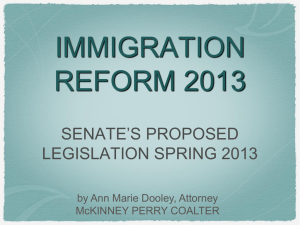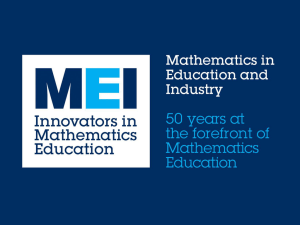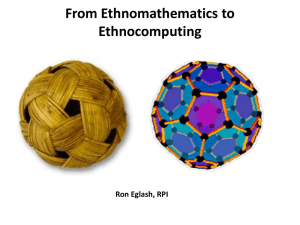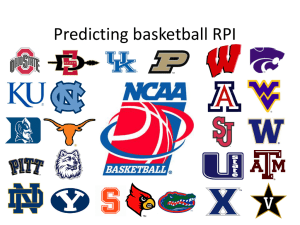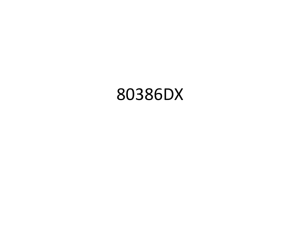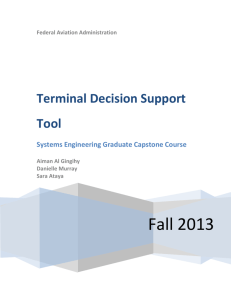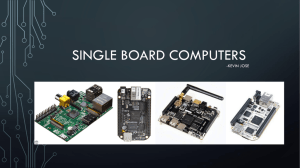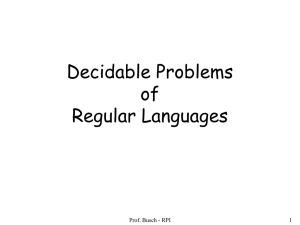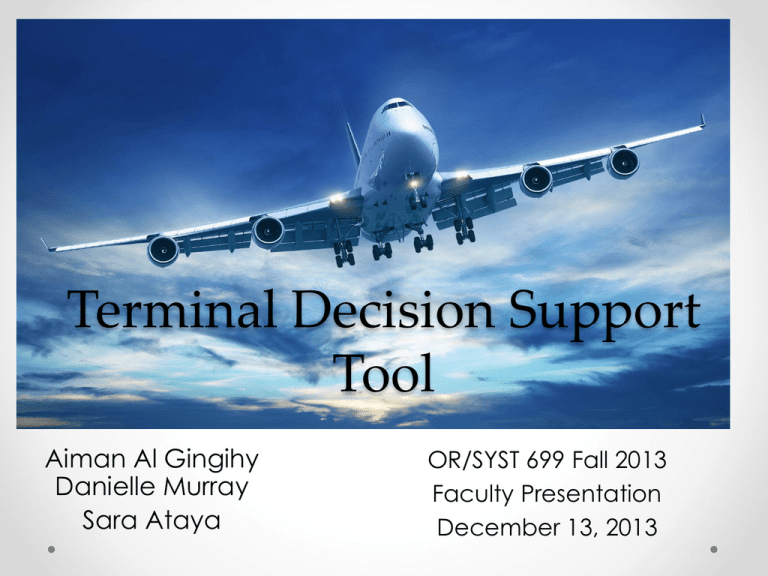
Terminal Decision Support
Tool
Aiman Al Gingihy
Danielle Murray
Sara Ataya
OR/SYST 699 Fall 2013
Faculty Presentation
December 13, 2013
Agenda
• Introduction
o Why are we here today?
o Who cares?
o Solving the problem
• Analysis
o Gap Analysis
o Alternatives Analysis
•
•
•
•
Recommendations
Next Steps
Acknowledgements
Questions?
2
Introduction
3
Why Are We Here Today?
• The Federal Aviation Administration (FAA) is
transforming the national airspace
•
Next Generation Air Transportation System (NextGen)
• What is NextGen?
o Agency initiate to move from a ground based system to a satellite system
• Why?
o
o
o
o
Shorter routes
Less time and fuel
Less traffic delays
More capacity
• How is team TDST going to look into solving this?
o By enabling the use of Performance Based Navigation in the Terminal
Environment
4
What is Performance Based
Navigation?
• Defines
performance
requirements
o More flexibility through
NAS
o Dynamic Management
of Aircraft
• How?
o Through advanced
procedures; RNAV/RNP
Procedures
o Optimize use of
airspace!!
Example of Complex Merge in Terminal Environment
5
Where is the Terminal
Environment??
TRACON Boundary
30 to 50 miles from airport
6
Who Cares??
Stakeholders; that’s who!
Terminal Controller
7
So What is the Problem?
• Terminal Controllers; the primary stakeholder do not
have a tool to allow aircraft to use these advanced
procedures
8
How We Will Solve This Problem
Methodology Approach!!
9
Gap Analysis
10
Current State
Future State
• Transition from
conventional routes to
advanced routes
• Current aircraft
equipage to fly these
procedures is about
60%
• Current utilization of
advanced procedures
NAS wide is 10%
• Enhance safety
aspects
• Reduce carbon
emissions
• Reduce flight delays
• Reduce noise impacts
• Deliver a more
efficient, consistent flow
of traffic down to the
runway
11
What is the “Formal” Gap??
1. Inability to continue efficient arrival operations into terminal
airspace
2. Lack of automation for Terminal controllers that can support
mixed equipage operations
RESULT: Pulling Aircraft off
approaches…..
Losing benefits from procedures…
WHICH, Jeopardizes
the investment the
agency has made
12
Remedies??
13
Actual Aircraft
2 nm
A Near-term Solution:
Relative Position
Indicator (RPI)
25 NM
Merge Point
7 nm
25 NM
2 nm
6 nm
Projected Aircraft
8 nm
Indicator
2 nm
Approved for Public Release; Distribution Unlimited. Case # 09-0127
© 2009 The MITRE Corporation. All rights reserved.
TSS Video
15
Relative Position Indicator
TSS Lite + RPI
Terminal Sequencing and
Spacing
R
e
m
e
d
i
e
s
Type of Display Aid
Methodology behind
Relative
Absolute
Absolute
Calculated Relative Position
Calculated Relative Position
Schedule Based Position
1 (STARS)
2 (STAR, ERAM, and TBFM)
3 (STARS, ERAM, and TBFM)
Mixed Equipage
Mixed Equipage
Mixed Equipage
Aids in Complex Merges
Aids in Complex Merges within
Aids in Complex Merges within
within Terminal Environment
Terminal Environment
Terminal Environment
Complement TBFM System
One piece of information
Developed within TBFM System
Display Aid
Number of System
Dependencies
Equipage
Environment
Connection with TBFM
inherent in TBFM
User
Benefits may vary based on
Benefits may incrementally
Precision of tools allows for
controller experience
improve with additional
inexperienced/ experienced
(inexperienced can gain
information for controller
controller to see benefits
No
Yes
Yes
No
Yes via sequence
Yes via speed and sequence
greater benefit)
Incorporation of Winds
for Solution?
Provide Trajectory
Solution?
Benefits
Reduces controller
workload
Early Application of
Speed Delay/Reduce
Delay Vectoring
Enables OPD
operations
Provides two more pieces
of information to
controllers to help
sequence a/c
Further reduces controller
Workload
Allow 95% a/c to stay on
RNP curved path approach
Provide streamlined arrival
solution; increasing
16
predictability
Alternatives Analysis
17
Methodology
18
Utility Analysis
• System Level Analysis
• Purpose
o
Help the decision maker identify
which alternative will best meet the
expectations of NextGen
• Alternatives
1.
2.
3.
TSS
TSS Lite & RPI
RPI
• Attributes
1.
2.
3.
4.
5.
6.
7.
8.
9.
10.
Time to Mature Capability
Time to Adapt/Train Capability
Maintain/Increase Throughput
RNP Utilization/Predictability
Fuel/Mission Saving
Reliability
Controller Acceptability
Systems Use
Target Accuracy
Collision
19
TSS
TSS Lite + RPI
RPI
(Runway assignments and
sequence numbers plus RPI)
Time to Mature Capability
5
5
7
Time to Adapt/Train
1= 1 year or more, 5 = five months, and 10 = 1 month.
7
8
9
Maintain/Increase Throughput
7
6
5
9
7
6
8
6
5
6
7
8
9
8
6
5
5
10
9
7
6
9
10
10
1 = TRL 1, 2, 5=TRL 4, 10= TRL 9
1= 0% increase, 5= 5% increase, 10= 10% increase
RNP Utilization/Predictability
1 = 50% of a/c stay on approach, 5 = 75%, 10= 100%
Fuel/Emissions
1 = 5% savings on fuel/emissions, 5 = 10%, 10 = 15%
Reliability
1= reliable 10% of the time, 5= reliable 75% of the time,
10= 100% of the time
Controller Acceptability
1= no buy in, 5 = somewhat buy in, 10 = greatly buy in
System Use
1= 0 facilities able to use capability, 5 = 35 facilities
able to use capability, 10 = 70 facilities or more able to
use capability
Target Accuracy
1 = not accurate, 5 = somewhat accurate, 10 = very
accurate
Collision Risk
1 = .001% risk 5 = .0001%, 10 = .00001% risk
20
Hierarchy
Decision Tree
• What is needed to
address the current
gap and meet
NextGen
expectations
• Weights generated
elicitation – swing
weights
• Are attributes
independent?
Best System to Enable Use of PBN
Time
Benefits
0.36
0.20
Op Suitability
0.44
Maturity
Throughput
Reliability
0.56
0.34
0.22
Adapt/Train
Utilization/Predicta
bility
Acceptability
0.44
0.43
Fuel/
Emissions
0.23
0.16
System Use
0.14
Target Accuracy
0.23
Collision
0.25
21
Value Function
Attribute
Value
Function
Maturity
0.20
Adapt/Train
0.16
Collision
0.11
Target Accuracy
0.10
Reliability
0.10
RNP Utilization/Predictability
0.09
Acceptability
0.07
Throughput
0.07
System Use
0.06
Fuel/Emissions
0.05
22
Alternative Ranking
Results of MAVT
23
Cost vs. Utility
Total Cost vs. Utility
Fixed Cost
0.72
TSS
$70M
TSS Lite/RPI
$12M
RPI
$10M
RPI
0.71
0.70
0.69
TSS
Utility
0.68
0.67
Reoccurring Cost
TSS Lite &
RPI
0.66
TSS
$450K
TSS Lite/RPI
$350K
RPI
$200K
0.65
$10
$30
$50
Total Cost (Million Dollar)
$70
24
Scenario Analysis
Alternatives
User
Scenario
Agency
Scenario
SE
Scenario
Benefits >
Time
Scenario
Equal Weights
for Level 1
Attributes
TSS
0.69
0.73
0.71
0.72
0.69
TSS Lite + RPI
0.66
0.65
0.68
0.66
0.64
RPI
0.72
0.66
0.72
0.67
0.68
25
Sensitivity Analysis
Performed
“what if”
analysis to study
the behavior of
the attribute
change as the
score changes
Ran
k
Attribute
Steepness/Slo
pe
1
Maturity
0.198
2
Adapt/Train
0.158
3
Collision
0.112
4
Target Accuracy
0.101
5
Reliability
RNP
Utilization/Predictability
0.098
7
Acceptability
0.073
8
Throughput
0.068
9
System Use
0.061
10
Fuel/Emissions
0.046
6
0.085
26
Final Conclusions/Recommendations
• The scores differ considerably between the ATC
perspective of values and FAA headquarters'
perspective.
• Recommend a meeting at the decision maker level
to set clear priorities on what is MOST important
• If cost is not an issue, one potential
recommendation is a phased approach of RPI
followed by TSS
o Allow agency to realize some sort of benefits in near term
If Decision Maker Priority
Is….
Capability
Time
RPI
Benefits
TSS
Cost
RPI
27
Next Steps
• Deliver final report
• Place emphasis that decision makers need to
determine clear priorities for defined attributes
• Provide alternatives analysis spreadsheet formulas
to key decision makers so they can see test different
scenarios
28
Acknowledgements
The Terminal Decision Support team would like to thank our FAA
Sponsor as well as team of Subject Matter Experts
Subject Matter Expert
Organization
En Route Controller/TBFM SME
Federal Aviation Administration
Former Airline Pilot/Current FAA Manager
Federal Aviation Administration
Terminal Automation SME
MITRE Corporation
Terminal/PBN Automation SME
Federal Aviation Administration
Dr Lance Sherry, Executive Director of the Center for Air
George Mason University
Transportation Systems Research
Paula Lewis, PA FAA - Assistant Administrator for Regions
George Mason University
and Center Operations
Dr. Andrew Loerch, Associate Professor/Associate Chair
SEOR Department
George Mason University
29
Questions?
Feedback
Aiman: aalgingi@gmail.com
Danielle: danielle.murray3@gmail.com
Sara: ataya.sara@gmail.com
Full List of References Available in
Final Report
30
Backup Slides
31
Description of Criteria
•
•
•
•
Time to Mature Capability: This metric represents how mature the actual capability is at
this point in time. This is a quantitative metric as both tools have undergone a maturity
assessment as recently as September 30, 2013. In terms of the analysis, 1 = TRL 1, 2, 5=TRL
4, 10= TRL 9. TRL speaks to the Technical Readiness Level of the Capability. We are
assuming that each capability would be brought to a max level of a TRL 9 before the
next stage in the lifecycle. The figure below describes each level in the TRL framework
[27].
Time to Adapt/Train: This metric is based upon research and development performed to
date. As RPI is incrementally more mature, this capability requires a much shorter
timeframe than TSS. As such, it will take a longer time for site adaptation and training. For
the purpose of this analysis, we recognize this time to be a reoccurring measure as this
step will need to take place at each site. This number is quantitative based upon analysis.
In terms of the analysis, 1= year or more, 5 = five months, and 10 = 1 month.
Maintain/Increase Throughput: Throughput is a measure of number of landings per hour
on a given runway. This metric is a qualitative relationship based upon individual data
derived from both TSS and RPI simulations. In terms of the analysis, 1= 0% increase to
throughput, 5= 5% increase, 10= 10% increase or more to throughput.
RNP Utilization/Predictability: This metric represents a key objective – making arrivals as
efficient as possible using PBN procedures. TSS provides a toolset which makes things as
efficient as possible being that it is based upon an absolute schedule. RPI does provide
greater efficiency compared to baseline operations but is not as efficient as TSS being
that it is a relative tool. Included in this metric, is the ability of controllers to keep aircraft
on RNP approaches. TSS has proved to be extremely efficient in keeping airplans on their
RNP curved path approaches. While RPI has also proven effectiveness with allowing
controllers to keep aircraft on PBN procedures, an evaluation of how many aircraft have
been taken off their RNP curved path approach has not been conducted. Nonetheless,
TSS demonstrates a clear gain in efficiency with controllers keeping aircraft on 95% of the
time. In terms of the analysis, 1 = 50% of a/c stay on approach, 5 = 75% of a/c stay on
32
approach, 10= 100% of a/c stay on approach.
Description of Criteria
•
•
•
•
•
•
Fuel/Emissions: This metric is based on both qualitative and quantitative data. While an apples to apples
comparison of the two capabilities cannot be performed, data and subject matter expertise opinion
demonstrates that TSS will provide more fuel and emissions savings than RPI. In terms of the analysis, 1 =
5% savings on fuel/emissions, 5 = 10% savings on fuel/emissions, 10 = 15% savings on fuel/emissions.
Reliability: This is the ability of the system to perform and maintain its functions in routine circumstances,
as well as unexpected circumstances. This includes off nominal situations where controllers are being
faced with difficult situations where the system is being tested in terms of sensitivity and flexibility. This is a
qualitative assessment based upon subject matter expertise. In terms of the analysis, 1= reliable 10% of
the time, 5= reliable 75% of the time, 10= 100% of the time..
Controller Acceptability: This metric represents the amount of buy in controllers have provided in regards
to both capabilities. Human factors element (reduce workload, etc)This metric is based upon controller
involvement in both RPI and TSS simulations and their subsequent feedback which has been
documented in simulation result reports. In terms of the analysis, 1= no buy in, 5 = somewhat buy in, 10 =
greatly buy in.
System Use: This metric represents how many facilities will be able to use the capability. TSS is dependent
on the facility having TBFM whereas RPI does not have a similar constraint. Both capabilities have a
dependency on STARS. The factor of what facilities will gain benefit from either/or is also taken into
account. The weights associated with this metric are qualitative based upon subject matter expertise of
all factors listed above. In terms of the analysis, 1= 0 facilities able to use capability, 5 = 35 facilities able
to use capability, 10 = 70 facilities or more able to use capability.
Target Accuracy: In specific terms, accuracy is a degree of closeness to the actual value. For this
analysis, we focus on the level of accuracy the system gives in terms to the information it displays to the
controllers. The more accurate the information, the more precisely they can deliver aircraft to the
runway. This is also a qualitative assessment based upon subject matter expertise. In terms of the
analysis, 1 = not accurate, 5 = somewhat accurate, 10 = very accurate.
Collision Risk: This metric was included to show that none of these capabilities truly have a collision risk.
All of these tools are decision support tools to the controllers and controllers are ultimately responsible for
separation of aircraft. In terms of the analysis, 1 = .001% risk 5 = .0001%, 10 = .00001% risk.
33

